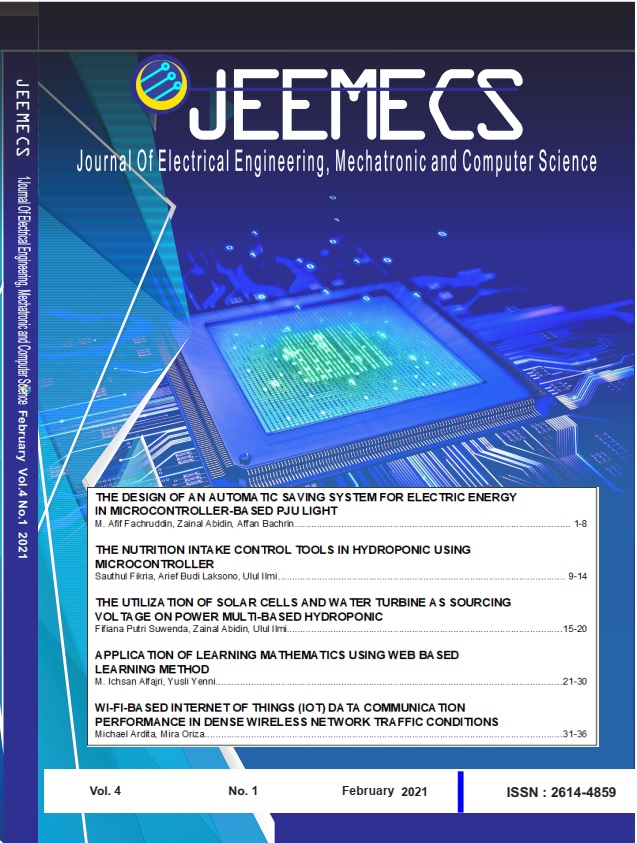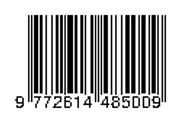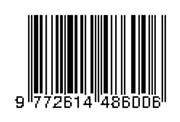THE DESIGN OF AN AUTOMATIC SAVING SYSTEM FOR ELECTRIC ENERGY IN MICROCONTROLLER-BASED PJU LIGHTS
DOI:
https://doi.org/10.26905/jeemecs.v4i1.4402Keywords:
Lamp Intensity, Movement, Photocell Sensor, PIR Sensor, LDR SensorAbstract
At this time, almost all Public Street Lights (PJU) still use the type of mercury and SON-T lamps, even though the mercury and SON-T lamps absorb a considerable amount of electricity. Public street lighting is usually on almost all nights, and this is a waste of electricity. Public street lighting is usually on most nights and thus is a waste of electricity. Usually, when it is past midnight, the streets are quiet, so the street lighting should be reduced in intensity to save electricity.  Based on this problem, this research uses an experimental method (Experiment) to create a design to make efforts in saving electricity. The method used includes electrical and systematic design. The steps taken include the stage of literature research, designing, manufacturing hardware and software, integrating the system, and testing and analyzing the system. Considering these theories, we can know the programming of the microcontroller ATMega 328, Photocell Sensor, PIR Sensor, LED Lights, and Power Supply. This research using several tests, including testing Photocell Sensor, PIR Sensors, LDR Sensors, and LED Lights. Photocell sensor to detect conditions day or night. PIR sensor functions to detect movement, LDR sensor to detect movement, LED lights are used to increase and decrease light intensity. For all the tests above, the results obtained when the PIR and LDR sensors have not detected any movement will dim the intensity of the LED lights. After the PIR and LDR sensors have detected the movement of the LED lights, they will turn automatically bright.
Â
Downloads
References
Arifianto D. Winarno. 2011. Kamus Komponen Elektronika. Surabaya : PT. Kawan Pustaka.
Iswanto. 2008. Belajar Mikrokontroller dengan Bahasa C. Yogyakarta : ANDI Yogyakarta
Sutikno. 2019. Rancang Bangun Smart Kontrol Lampu Penerangan Jalan Umum Berbasis SMS Gateway.
Sutono. 2014. Menggunakan Sensor Gerak Dan Sensor Cahaya Berbasis Arduino. vol. 12, no. 2, pp. 223–232, 2014.
Tresna Umar Syamsuri. 2017. Kontrol Lampu Jalan Untuk Hemat Energi. Jurnal Politeknik Negeri Malang Vol. 7
Taufik Tauladan, Fitri Latifah. 2017. Sistem Kendali Otomatis Hemat Energi Pada Penerangan Lampu Jalan TOL LDR, Infrared Dengan Mikrikontroller AT89S52. Informatics For Educators And Profesionals Vol. 1
Wilyanto, Firdaus, Wahyudi Budi Pramono, Ida Nurcahyani. 2017. Sistem Pengauturan Pencahayaan ruang Kuliah Untuk Mendukung Program Hemat Energi Berbasis Wireless Sensor Network. Prosiding SNATIF Vol. 4
https://www.immersa-lab.com/pengertian-sensor-passive-infra-red-dan-cara-kerjanya. (Diakses pada 2 Januari 2020):
http://www.labelelektronika.com/2017/02/arduinomega-2560-mikrokontroller. (Diakses pada 4 Januari 2020)
http://eprints.polsri.ac.id (Diakses pada 4 Januari 2020)
Zulfian Azmi, Safiul Nur Arif, Elvis.T.Pasaribu. 2018. Implementasi Kecerdasan Buatan Untuk Sistem Kendali Lampu Jalan Berbasis Mikrokontroller. Sains dan Komputer (SAINTIKOM) Vol. 17.
Downloads
Additional Files
Published
Issue
Section
License
Our ethic statements are based on COPE’s Best Practice Guidelines for Journal Editors.
Publication decisions
The editor is responsible for deciding which of the articles submitted to the journal should be published.
The editor may be guided by the policies of the journal's editorial board and constrained by such legal requirements as shall then be in force regarding libel, copyright infringement and plagiarism. The editor may confer with other editors or reviewers in making this decision.
Fair play
An editor at any time evaluate manuscripts for their intellectual content without regard to race, gender, sexual orientation, religious belief, ethnic origin, citizenship, or political philosophy of the authors.
Confidentiality
The editor and any editorial staff must not disclose any information about a submitted manuscript to anyone other than the corresponding author, reviewers, potential reviewers, other editorial advisers, and the publisher, as appropriate.
Disclosure and conflicts of interest
Unpublished materials disclosed in a submitted manuscript must not be used in an editor's own research without the express written consent of the author.
Duties of Reviewers
Contribution to Editorial Decisions
Peer review assists the editor in making editorial decisions and through the editorial communications with the author may also assist the author in improving the paper.
Promptness
Any selected referee who feels unqualified to review the research reported in a manuscript or knows that its prompt review will be impossible should notify the editor and excuse himself from the review process.
Confidentiality
Any manuscripts received for review must be treated as confidential documents. They must not be shown to or discussed with others except as authorized by the editor.
Standards of Objectivity
Reviews should be conducted objectively. Personal criticism of the author is inappropriate. Referees should express their views clearly with supporting arguments.
Acknowledgement of Sources
Reviewers should identify relevant published work that has not been cited by the authors. Any statement that an observation, derivation, or argument had been previously reported should be accompanied by the relevant citation. A reviewer should also call to the editor's attention any substantial similarity or overlap between the manuscript under consideration and any other published paper of which they have personal knowledge.
Disclosure and Conflict of Interest
Privileged information or ideas obtained through peer review must be kept confidential and not used for personal advantage. Reviewers should not consider manuscripts in which they have conflicts of interest resulting from competitive, collaborative, or other relationships or connections with any of the authors, companies, or institutions connected to the papers.
Duties of Authors
Reporting standards
Authors of reports of original research should present an accurate account of the work performed as well as an objective discussion of its significance. Underlying data should be represented accurately in the paper. A paper should contain sufficient detail and references to permit others to replicate the work. Fraudulent or knowingly inaccurate statements constitute unethical behavior and are unacceptable.
Originality and Plagiarism
The authors should ensure that they have written entirely original works, and if the authors have used the work and/or words of others that this has been appropriately cited or quoted.
Multiple, Redundant or Concurrent Publication
An author should not in general publish manuscripts describing essentially the same research in more than one journal or primary publication. Submitting the same manuscript to more than one journal concurrently constitutes unethical publishing behaviour and is unacceptable.
Acknowledgement of Sources
Proper acknowledgment of the work of others must always be given. Authors should cite publications that have been influential in determining the nature of the reported work.
Authorship of the Paper
Authorship should be limited to those who have made a significant contribution to the conception, design, execution, or interpretation of the reported study. All those who have made significant contributions should be listed as co-authors. Where there are others who have participated in certain substantive aspects of the research project, they should be acknowledged or listed as contributors.
The corresponding author should ensure that all appropriate co-authors and no inappropriate co-authors are included on the paper, and that all co-authors have seen and approved the final version of the paper and have agreed to its submission for publication.
Disclosure and Conflicts of Interest
All authors should disclose in their manuscript any financial or other substantive conflict of interest that might be construed to influence the results or interpretation of their manuscript. All sources of financial support for the project should be disclosed.
Fundamental errors in published works
When an author discovers a significant error or inaccuracy in his/her own published work, it is the author’s obligation to promptly notify the journal editor or publisher and cooperate with the editor to retract or correct the paper.











